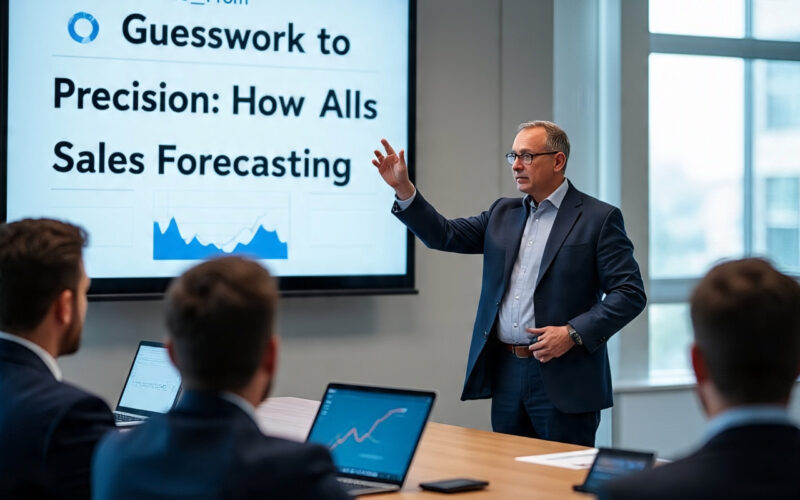Every company thinks its sales forecast is solid–until the quarter ends.
You see it everywhere: leadership goes all-in on aggressive targets, sales teams scramble, and RevOps spends weeks building slide decks to justify numbers that no one really believes.
Most of those forecasts look good on paper. Weighted probabilities. Color-coded stages. Fancy dashboards. But behind all that polish hides a simple truth: the system runs on guesswork. Reps overestimate, managers adjust, executives “round up.” It’s an endless cycle of optimism, correction, and disappointment.
I’ve watched VPs defend a forecast they secretly doubted. I’ve seen finance teams plan budgets based on numbers pulled from thin air. Everyone nods in meetings, but deep down, they know the model is flawed. The math might be right, but the assumptions aren’t.
And the worst part? Nobody admits it, because everyone’s been trained to pretend forecasting is objective.
Why traditional forecasting keeps breaking
Spreadsheets weren’t designed for volatility. Neither were human brains.
Sales cycles have become unpredictable–more decision-makers, longer approvals, fluctuating budgets. A deal that looked “certain” in Q1 can vanish by Q2. The data you used to trust becomes irrelevant within days. Yet companies still rely on the same manual inputs and historical averages.
Human judgment is biased. Reps inflate probabilities to please managers. Managers adjust forecasts to please executives. Executives tweak numbers to please investors. At every layer, distortion grows.
The result? A neat table that hides chaos.
That’s why so many companies miss their targets even when the pipeline looks healthy. They aren’t forecasting revenue, they’re forecasting hope.
The hidden cost of uncertainty
Uncertainty is silent but expensive. When forecasts are wrong, everything downstream collapses.
Hiring decisions get delayed. Marketing spends get frozen. Product teams pause launches because nobody knows what the next quarter looks like. Finance teams build cash-flow models that age faster than milk.
And it’s not just about money. Uncertainty eats culture. Reps lose motivation when targets feel arbitrary. Managers lose credibility when numbers shift every week. Leadership loses confidence when nothing adds up.
I’ve met founders who told me the hardest part of scaling wasn’t finding customers – it was trusting their own data.
That’s the problem Forecastio.ai set out to solve: turning uncertainty into precision. But before we get to that, you need to understand what’s fundamentally broken in the way forecasting happens today.
The data is lying to you.
CRMs were built to record activity, not predict behavior.
So yes, you can log calls, meetings, and deal values, but that doesn’t mean the data is clean or meaningful. Reps forget to update fields. Some deals are duplicated. Probabilities are copied and pasted from old templates. By the time a forecast reaches the leadership table, it’s already corrupted by omission and bias.
Most teams think they have a data problem. In reality, they have a human-input problem.
Forecasting accuracy dies the moment data depends on someone’s mood.
AI doesn’t fix that by magic – it fixes it by learning how humans behave. That’s the quiet revolution behind platforms like Forecastio.ai. It observes patterns across reps, territories, and cycles. It learns that Rep A’s “80% confidence” means something very different from Rep B’s. It tracks how often deals slip, how long they stay idle, and how fast certain types recover.
Over time, it develops intuition, but based on math, not emotion.
The difference between data and insight
Every company collects data. Very few understand it.
Raw numbers tell you what happened. Insight tells you why.
That’s the gap where most forecasts die. You can have thousands of deals logged, yet still have no clue which will close. Traditional models treat all data equally. AI models, like those behind Forecastio.ai, weigh it contextually. They spot invisible signals, time of last activity, deal inertia, sentiment in notes, seasonal drop-offs, and translate them into probabilities that actually behave like reality.
Once that happens, everything changes.
Forecasts stop being static charts and become living predictions. Leadership stops debating “gut feel” and starts discussing outcomes. And because the model evolves continuously, it gets sharper each week.
That’s the real promise of AI forecasting. It’s not about automation for automation’s sake. It’s about intelligence that compounds.
What life looks like before and after
Picture a Monday morning without AI. RevOps opens five spreadsheets. Data conflicts. The VP asks why two systems show different totals. The sales director shrugs. The CFO frowns. Everyone agrees to “re-sync the data.” By Wednesday, the forecast still doesn’t make sense.
Now picture the same week with Forecastio.ai integrated into HubSpot. The forecast updates itself in real time. The system shows which deals have gone cold, which are heating up, and which are likely to slip. Instead of debating inputs, the team discusses strategy.
AI doesn’t remove humans from the equation – it removes confusion.
It gives every role clarity:
- RevOps stops firefighting.
- Sales leaders coach proactively.
- Finance gets numbers they can model around.
- Founders stop guessing whether they can hire.
When forecasting becomes reliable, confidence replaces chaos.
The messy middle: when data gets real
Here’s the uncomfortable truth: most “bad forecasts” aren’t about bad math – they’re about incomplete context.
A rep logs a deal worth €50K with a 90% probability. Great. But the AI sees what humans ignore: that this rep’s 90% deals close only 40% of the time, and they always slip two weeks. That one insight saves a company from building fantasy revenue.
Forecastio.ai captures that nuance. It tracks every change in your HubSpot data: who moved a deal, who changed an amount, who adjusted the stage. That audit trail doesn’t just build transparency. It teaches the system how trustworthy each input is.
Soon, your forecast isn’t “based on data.” It is the data.
The everyday pain points
How most sales teams experience forecasting today:
- Endless manual updates that eat hours and still feel wrong
- Numbers that shift daily because data hygiene breaks down
- Forecast meetings that feel more like therapy sessions
- Leadership promising results based on hunches
- Finance building budgets, they secretly don’t trust
It’s exhausting.
And the craziest part? Everyone assumes that’s normal.
When AI starts paying attention
Artificial intelligence doesn’t get tired. It doesn’t forget to update fields or overestimate to look good. It watches patterns.
When plugged into HubSpot, Forecastio.ai starts analyzing every micro-movement in your pipeline – frequency of updates, size of deals, rep behavior, and seasonal effects. Then it starts predicting outcomes weeks before humans would notice them.
A deal that looks “fine” on paper might trigger a red flag in the system. Why? Because the AI remembers that similar deals stalled after five days of silence. It doesn’t rely on assumptions. It relies on evidence.
That’s why RevOps teams describe AI forecasting as addictive. Once you see how close it gets, you stop trusting anything else.
Why precision matters more than ambition
Companies don’t fail because they aim too high. They fail because they aim blindly.
Forecast accuracy is the backbone of every strategic move. You can’t scale hiring, adjust pricing, or secure funding without it. Investors don’t believe “maybe.” Boards don’t fund “we think.”
AI gives leaders something they’ve never had before – forecast confidence grounded in data integrity. Forecastio.ai achieves up to 95% accuracy by continuously validating your HubSpot information against real-world outcomes.
It’s the difference between guessing and knowing.
And when you know, you move faster. You make bolder calls. You act like a company that actually understands its future.
The ripple effects of accuracy
What happens once forecasts become trustworthy:
- Budgets align seamlessly with expected revenue
- Teams coach based on data, not emotion
- Growth strategies extend beyond the next quarter
- Finance stops correcting sales; sales start enabling finance
- Leadership plans expansion with measurable confidence
Forecasting isn’t a report anymore – it’s an operating rhythm.
The human side of automation
There’s a misconception that AI replaces human intuition. In reality, it empowers it.
Reps still build relationships. Managers still make calls. Founders still decide direction. The difference is that those decisions now happen on solid ground.
When your team knows the numbers are accurate, they stop obsessing over spreadsheets and start focusing on performance. Forecast meetings turn from defensive arguments into strategy sessions.
That’s why people who use Forecastio.ai rarely go back. It’s not about shiny dashboards. It’s about peace of mind.
When culture shifts from reaction to readiness
Every organization has a defining moment where it stops reacting and starts preparing.
AI forecasting accelerates that moment.
Because once the data starts learning, everyone’s behavior changes. Reps log updates faster because they see instant feedback. Managers coach earlier. RevOps becomes proactive instead of corrective.
Culture follows clarity.
And once that clarity exists, you can feel it – in meetings, in targets, in the tone of leadership. The entire organization starts operating like a precision system instead of a collection of guesses.
Where we go from here
AI forecasting isn’t futuristic anymore. It’s the new baseline.
Companies that keep relying on manual systems will lag bot because they sell less, but because they plan worse. The competitive edge isn’t in having more leads – it’s in knowing what those leads are worth.
Forecastio.ai represents that shift from instinct to intelligence. It’s part of a broader movement where every metric becomes accountable and every decision measurable.
And the sales forecasting tool you choose today decides how fast that transformation happens.
The end of guesswork
The guessing era is over.
There’s too much data, too much noise, too much risk to keep doing this by hand. You can keep calling it “forecasting,” but without AI, it’s gambling with spreadsheets.
Forecastio.ai doesn’t promise perfection. It promises precision that compounds – forecasts that get smarter, cleaner, and more accurate with every deal logged.
That’s what modern sales forecasting looks like. It’s not magic. It’s math, finally done right. And when you experience it, you’ll wonder how you ever operated without it.




